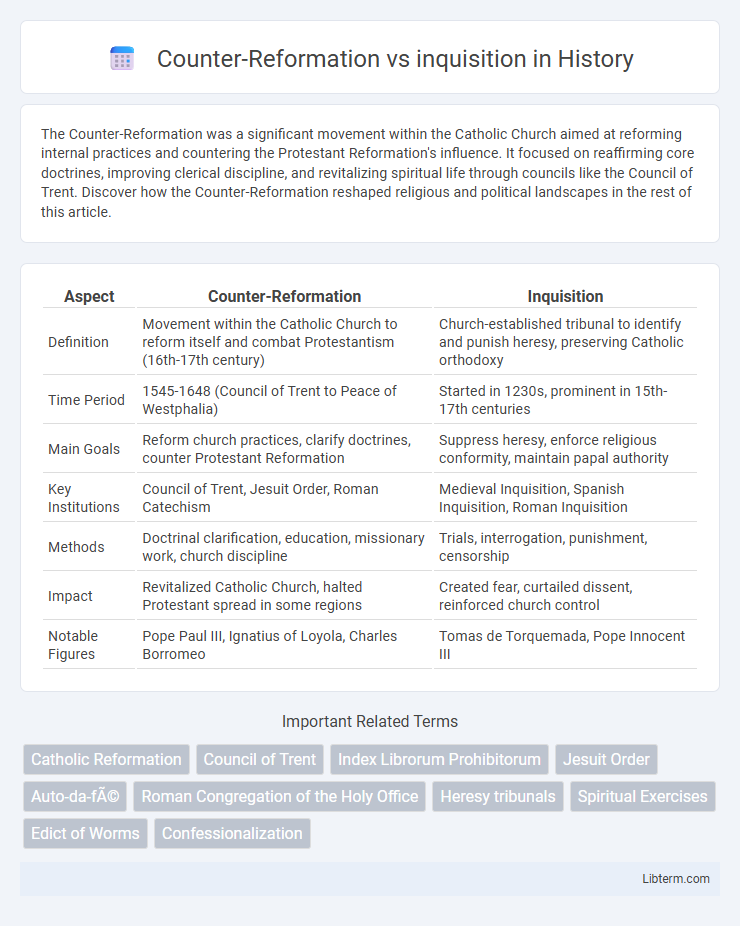The Counter-Reformation was a significant movement within the Catholic Church aimed at reforming internal practices and countering the Protestant Reformation's influence. It focused on reaffirming core doctrines, improving clerical discipline, and revitalizing spiritual life through councils like the Council of Trent. Discover how the Counter-Reformation reshaped religious and political landscapes in the rest of this article.
Table of Comparison
| Aspect | Counter-Reformation | Inquisition |
|---|---|---|
| Definition | Movement within the Catholic Church to reform itself and combat Protestantism (16th-17th century) | Church-established tribunal to identify and punish heresy, preserving Catholic orthodoxy |
| Time Period | 1545-1648 (Council of Trent to Peace of Westphalia) | Started in 1230s, prominent in 15th-17th centuries |
| Main Goals | Reform church practices, clarify doctrines, counter Protestant Reformation | Suppress heresy, enforce religious conformity, maintain papal authority |
| Key Institutions | Council of Trent, Jesuit Order, Roman Catechism | Medieval Inquisition, Spanish Inquisition, Roman Inquisition |
| Methods | Doctrinal clarification, education, missionary work, church discipline | Trials, interrogation, punishment, censorship |
| Impact | Revitalized Catholic Church, halted Protestant spread in some regions | Created fear, curtailed dissent, reinforced church control |
| Notable Figures | Pope Paul III, Ignatius of Loyola, Charles Borromeo | Tomas de Torquemada, Pope Innocent III |
Introduction to the Counter-Reformation and the Inquisition
The Counter-Reformation, initiated by the Catholic Church in the mid-16th century, aimed to reform internal abuses and counter the spread of Protestantism. The Inquisition, established earlier but intensified during this period, functioned as a judicial institution to identify, try, and punish heretics, maintaining religious orthodoxy. Both played crucial roles in reinforcing Catholic doctrine and consolidating church authority across Europe.
Historical Context: Causes of the Counter-Reformation
The Counter-Reformation emerged in the 16th century as a direct response to the Protestant Reformation, aiming to reform internal Church practices and reaffirm Catholic doctrine. Its causes include widespread criticism of clerical corruption, abuses such as the sale of indulgences, and the challenge to papal authority posed by reformers like Martin Luther. The Roman Catholic Church initiated the Counter-Reformation to combat Protestant expansion and restore religious unity through measures including the Council of Trent and the strengthening of the Inquisition.
The Role of the Catholic Church during the Counter-Reformation
The Catholic Church played a pivotal role in the Counter-Reformation by initiating comprehensive reforms to address corruption, reaffirm doctrines, and strengthen church discipline through the Council of Trent (1545-1563). The Inquisition, as an instrument of the Church, was employed to enforce orthodoxy, combat heresy, and suppress Protestantism by conducting investigations, trials, and punishments. These combined efforts revitalized Catholicism in Europe, curbed the spread of Protestant movements, and reasserted papal authority throughout the 16th and 17th centuries.
The Inquisition: Origins and Purpose
The Inquisition originated in the 12th century as a Catholic Church institution aimed at identifying and suppressing heresy to maintain religious unity and authority. It was institutionalized during the Counter-Reformation in the 16th century to combat Protestantism and enforce Catholic doctrine through investigation, trial, and punishment of suspected heretics. The Inquisition's purpose extended beyond religious conformity, reinforcing the Church's dominance and often employing methods like interrogation and censorship.
Key Figures in the Counter-Reformation and the Inquisition
Key figures in the Counter-Reformation include Ignatius of Loyola, founder of the Jesuits, who played a pivotal role in revitalizing Catholic education and missionary work. Pope Paul III was instrumental in initiating the Council of Trent, which defined Catholic doctrine and reformed Church practices. In contrast, the Inquisition was led by figures like Tomas de Torquemada, the first Grand Inquisitor in Spain, known for enforcing Catholic orthodoxy through tribunals and suppressing heresy.
Methods and Tactics: Reform vs. Repression
The Counter-Reformation employed methods of internal Church reform such as revitalizing spiritual discipline, establishing new religious orders like the Jesuits, and promoting education to counter Protestantism. In contrast, the Inquisition utilized repressive tactics including interrogation, trial, and punishment to enforce orthodoxy and suppress heresy. While the Counter-Reformation focused on renewal and persuasion, the Inquisition emphasized coercion and fear to maintain religious conformity.
Impact on European Society and Culture
The Counter-Reformation revitalized Catholic doctrine and practices, strengthening religious institutions and influencing art, education, and political power across Europe. The Inquisition enforced religious uniformity through trials and persecution, creating an atmosphere of fear that suppressed dissent and intellectual freedom. Together, these movements shaped European society by reinforcing Catholic dominance while restricting religious pluralism and cultural diversity.
Comparisons: Counter-Reformation vs. Protestant Reformation
The Counter-Reformation, spearheaded by the Catholic Church, aimed to reform internal corruption and reaffirm Catholic doctrine in direct response to the Protestant Reformation's challenges. Unlike the Protestant Reformation, which emphasized salvation through faith and scriptural authority, the Counter-Reformation reinforced traditional practices such as the sacraments, papal authority, and church hierarchy. Both movements shaped European religious landscape, with the Counter-Reformation utilizing institutions like the Inquisition to combat heresy and strengthen Catholic unity.
Legacy of the Inquisition in Modern Memory
The Inquisition's legacy persists in modern memory as a symbol of religious intolerance and judicial severity, often overshadowing the broader reforms of the Counter-Reformation. This dark chapter is frequently cited in discussions about abuses of power by religious institutions, influencing secular legal frameworks and human rights discourse. The enduring image of the Inquisition shapes contemporary views on religious persecution and the limits of ecclesiastical authority.
Lasting Effects of the Counter-Reformation and Inquisition
The Counter-Reformation solidified Catholic doctrine and revitalized the Church's influence through reforms in education, liturgy, and missionary work, producing a lasting resurgence in Catholicism that shaped European religious and political landscapes. The Inquisition, as an enforcement mechanism, intensified religious conformity and suppressed heretical movements, leaving a legacy of fear, censorship, and judicial practices that influenced both church and secular courts. Together, these movements entrenched a divide between Protestant and Catholic regions, fundamentally altering religious tolerance and governance across Europe.
Counter-Reformation Infographic

 libterm.com
libterm.com